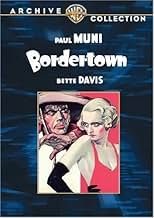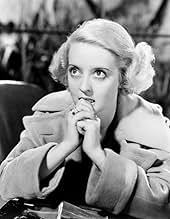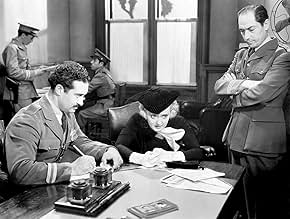IMDb RATING
6.6/10
2.1K
YOUR RATING
In Mexico, a former lawyer becomes the invaluable second-in-command to a casino owner, whose wife begins to fall for him.In Mexico, a former lawyer becomes the invaluable second-in-command to a casino owner, whose wife begins to fall for him.In Mexico, a former lawyer becomes the invaluable second-in-command to a casino owner, whose wife begins to fall for him.
Soledad Jiménez
- Mrs. Ramirez
- (as Soledad Jimenez)
William B. Davidson
- Dr. Carter
- (as William Davidson)
Oscar Apfel
- Judge Rufus Barnswell
- (uncredited)
Wade Boteler
- Man Wanting to Buy Roark's Casino
- (uncredited)
Jack Chefe
- Waiter
- (uncredited)
Wallis Clark
- Friend of Dean on Podium
- (uncredited)
Carlos De Valdez
- Magistrado
- (uncredited)
Featured reviews
"Bordertown" features a far more convincing performance from Paul Muni, who manages to curtail his usual theatrical approach to film acting. Bette Davis is an excellent female lead for Muni and their scenes radiate with tension. Maragret Lindsay is OK in the supporting cast but she isn't in Davis's league. Paul Muni plays a newly qualified lawyer who decides to make a career for himself near the Mexican border after some problems earlier on in the film. He is employed by a wealthy businessman (Eugene Pallete) to handle all the legal wranglings for his building firm. However, trouble soon rears its head in the form of the businessman's wife, Bette Davis. The second half of "Bordertown" was remade by "Warner Bros" for the 1940 film, "They Drive By Night." It is a coin toss as to who is more fiery and feisty out of Bette Davis and Ida Lupino in the same role. For me, it is an even draw. The plot and the narrative are both strong and with some good dialogue. This is one of the best films Paul Muni whilst at "Warner Bros."
A film where everyone gets whats coming to them, and true to the 1930's formula, in melodramatic fashion. Featuring the now forgotten Paul Muni (was he really a superstar back then?) as a Hispanic lawyer who learns a hard lesson about the facts of life. Muni, as usual plays it weird; before and after Bordertown, he is a pretty normal guy but while he is in Bordertown he becomes a Hispanic parody. But nevermind that, this film has Bette Davis playing yet another scheming psychopath as only she can. Like the several other Davis movies that she had a minor role in ("Fog over Frisco" and "In This Our Life", to name two), her twisted character stays with you long after she is gone. Plus, she's a blonde! Yowza!
Paul Muni is a Mexican-American who has graduated from night law school, but soon learns that a law degree doesn't make you a lawyer. He heads out of town and gets a job as a bouncer at Eugene Pallette's bar. He quickly becomes so invaluable that Pallette cuts him in for a quarter of the take. Meanwhile, Pallette's wife, Bette Davis, develops an itch for him.
Muni is terrific, as always, and the cast, which includes Margaret Lindsay, Henry O'Neill, and Soledad Jiménez, work very well in this tale about a man trying to crash through the racial barrier the right way. That the film makers got this much through the Production Code is a major accomplishment, but this needs to have been a pre-code movie, with all the dirt and sluttishness that implies.
Muni is terrific, as always, and the cast, which includes Margaret Lindsay, Henry O'Neill, and Soledad Jiménez, work very well in this tale about a man trying to crash through the racial barrier the right way. That the film makers got this much through the Production Code is a major accomplishment, but this needs to have been a pre-code movie, with all the dirt and sluttishness that implies.
As a poor Mexican-American boy, Muni labors to get a night-school law degree, but can't make a professional living in such a poor neighborhood. Ambitious and tough, he works his way into heading a gambling casino. Though a financial success, he loses his way in a white- dominated social world.
It's 1934 and the notorious Hollywood Production Code has just kicked in. Few studios were more affected than Warner Bros., the home of the uncompromising gangster films of Cagney, Robinson, and Muni. There are elements of the typical rags-to-riches gangster theme in this movie, but the tone and content have altered from the pre-Code product. Note the complete absence of gunplay, dead bodies, brutality, and other staples of such pre-Code classics as Public Enemy (1931), Little Caesar (1931), and Scarface (1932).
Technically, this is not a gangster movie-- Muni may be shady, yet he's no criminal. But that too, I believe, results from trying to get right with the new Code. Note how business rivals try to buy out Palette's casino instead of just muscling-in in classic gangster fashion. And though the girls sport some pretty revealing gowns, Muni refuses Davis's overtures, while remaining unclear on his relationship with Lindsey. Such compromises likely result from the producers not wanting sexual relationships to cross racial lines. Contrast this with the strong hints of incest, no less, in the free-wheeling Scarface.
In short, the movie has the trappings of a gangster film, yet departs in ways that I think are traceable to the newly installed Code. Among others, the new strictures were supposed to end public enthrallment with the underworld by deglamorizing it. Thus, Bordertown lacks many of the risky elements that made Warner Bros. such a riveting and dynamic studio during its classical period.
Now, this is not to say the movie is without interest or entertainment value. It took some guts to make Muni's central character a Mexican-American and cast him in a sympathetic light. In fact, the only thoroughly dislikable character is Lindsey's snobbish white boyfriend (Manville). At the same time, I agree with others who think Muni's performance is too florid, along with an accent that sort of comes and goes. He looks the part, but never gets past the impersonation stage. On the other hand, Davis's one scene of nervous frustration while alone in a room is a little gem of mounting hysteria, and makes me appreciate how well she emoted with her expressive eyes. However, it's Margaret Lindsay who walks off with the movie, at least in my view. Her devious upper-class lady is compellingly natural and unaffected, an interesting contrast to Muni's undiluted staginess.
Anyway, the movie may be a come-down from Warner's pre-Code product, but still includes a couple of good twists (e.g. the first courtroom scene). It's also worth a look-see for anyone interested in the evolution of the gangster movie.
It's 1934 and the notorious Hollywood Production Code has just kicked in. Few studios were more affected than Warner Bros., the home of the uncompromising gangster films of Cagney, Robinson, and Muni. There are elements of the typical rags-to-riches gangster theme in this movie, but the tone and content have altered from the pre-Code product. Note the complete absence of gunplay, dead bodies, brutality, and other staples of such pre-Code classics as Public Enemy (1931), Little Caesar (1931), and Scarface (1932).
Technically, this is not a gangster movie-- Muni may be shady, yet he's no criminal. But that too, I believe, results from trying to get right with the new Code. Note how business rivals try to buy out Palette's casino instead of just muscling-in in classic gangster fashion. And though the girls sport some pretty revealing gowns, Muni refuses Davis's overtures, while remaining unclear on his relationship with Lindsey. Such compromises likely result from the producers not wanting sexual relationships to cross racial lines. Contrast this with the strong hints of incest, no less, in the free-wheeling Scarface.
In short, the movie has the trappings of a gangster film, yet departs in ways that I think are traceable to the newly installed Code. Among others, the new strictures were supposed to end public enthrallment with the underworld by deglamorizing it. Thus, Bordertown lacks many of the risky elements that made Warner Bros. such a riveting and dynamic studio during its classical period.
Now, this is not to say the movie is without interest or entertainment value. It took some guts to make Muni's central character a Mexican-American and cast him in a sympathetic light. In fact, the only thoroughly dislikable character is Lindsey's snobbish white boyfriend (Manville). At the same time, I agree with others who think Muni's performance is too florid, along with an accent that sort of comes and goes. He looks the part, but never gets past the impersonation stage. On the other hand, Davis's one scene of nervous frustration while alone in a room is a little gem of mounting hysteria, and makes me appreciate how well she emoted with her expressive eyes. However, it's Margaret Lindsay who walks off with the movie, at least in my view. Her devious upper-class lady is compellingly natural and unaffected, an interesting contrast to Muni's undiluted staginess.
Anyway, the movie may be a come-down from Warner's pre-Code product, but still includes a couple of good twists (e.g. the first courtroom scene). It's also worth a look-see for anyone interested in the evolution of the gangster movie.
Confronting Muni in one scene, Davis suddenly so forcefully expels cigarette smoke from her nose that she looks like a cartoon bull about to charge. But though it's funny, it's not ludicrous: it's one of those startling, inspired B.D. moments.
Warners cast Davis in "Bordertown" when it became apparent that her just-completed loanout to RKO for "Of Human Bondage" was not going to wreck her career, as Warners had feared. Instead, as Davis had gambled, the risky "Bondage" had been her breakout performance. "Bordertown" was a worthy follow-up, with Davis just as compelling as the obsessor rather than the obsessee.
Warners cast Davis in "Bordertown" when it became apparent that her just-completed loanout to RKO for "Of Human Bondage" was not going to wreck her career, as Warners had feared. Instead, as Davis had gambled, the risky "Bondage" had been her breakout performance. "Bordertown" was a worthy follow-up, with Davis just as compelling as the obsessor rather than the obsessee.
Did you know
- TriviaAt first, Paul Muni wanted Carole Lombard or Lupe Velez as female co-star, but after her success in L'emprise (1934) he chose Bette Davis.
- GoofsWhen Johnny Ramirez shortly after losing the case leaves his home and starts hitchhiking, you see a montage of calendar months indicating the passage of time. But the dates of the month do not correspond with the year 1934, which was the year of the trial as indicated by the court papers filed. Also, the sequence of calendar dates shown in the montage is out of order. They begin with August of 1936 and end with July 1936 as opposed to July 1937.
- Quotes
Marie Roark: The only fun I get is feeding the goldfish, and they only eat once a day.
- ConnectionsFeatured in Code of the Secret Service (1939)
- SoundtracksMaria Elena
(1933) (uncredited)
Music by Lorenzo Barcelata
Played at the beginning and often in the score
- How long is Bordertown?Powered by Alexa
Details
- Release date
- Country of origin
- Languages
- Also known as
- Bordertown
- Filming locations
- Los Angeles, California, USA(Olvera Street in opening scene)
- Production companies
- See more company credits at IMDbPro
- Runtime1 hour 30 minutes
- Color
- Sound mix
- Aspect ratio
- 1.37 : 1
Contribute to this page
Suggest an edit or add missing content




































